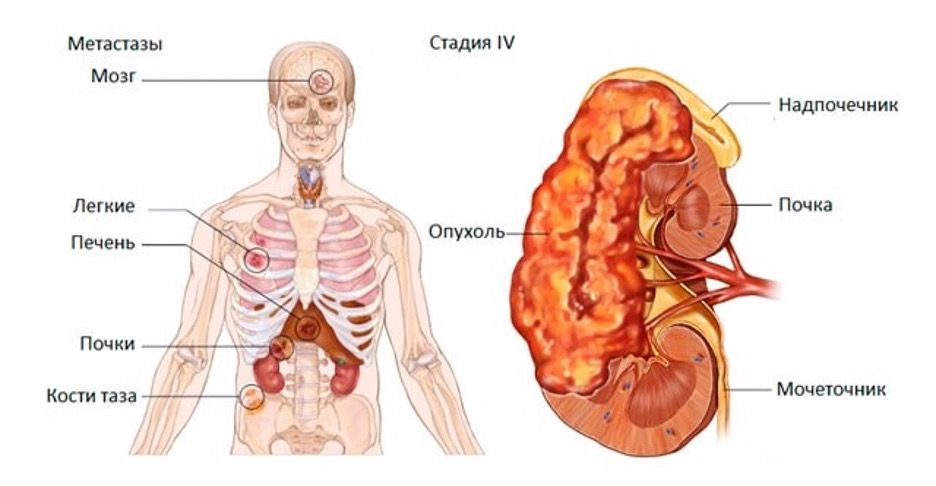Metastasis: what is it?
Metastases are secondary lesions that are located at a distance from the primary tumor: in other organs, lymph nodes. They are formed by malignant cells separated from the primary neoplasm, migrated with the blood or lymph flow and settled in various organs.
In the form of tumor lesions - the same as the primary tumor. Sometimes it is not even possible to immediately understand what the detected neoplasm is: a primary tumor or a metastasis.
Metastases can be located in different places. It depends on the cancer type - everyone has their "favorite" localizations. Most often, secondary foci appear in the lungs, liver, peritoneum, bones, adrenal glands. Some metastases are very specific and have their own names - for example, Virchow's node in gastric cancer.
The "Metastasis" word is of Greek origin and literally means "dislocation".Now that we have understood what metastases are, let's talk about how they arise. In accordance with modern concepts, metastasis is a process that often begins almost immediately after the onset of a malignant tumor. Some cells separate from the primary lesion and penetrate into the lumen of the lymphatic or blood vessels. They move in the body with the lymph or blood flow, and then settle in certain organs and give rise to new foci there. These pathways of metastasis are called lymphogenous and hematogenous, respectively.
In the beginning, metastasis occurs very slowly and is difficult to detect. The immune system destroys cancer cells migrating in the body, and the primary tumor suppresses the growth of secondary lesions.
If during the examination distant metastases are already detected, then the patient is diagnosed with metastatic cancer. This diagnosis corresponds to stage IV malignant tumor.
So, in simple terms, metastases are tumor foci that are formed in different organs in addition to the primary tumor. The ability to metastasize is one of the key properties of malignant tumors, which distinguishes them from benign neoplasms. Often it is metastases that cause the death of a cancer patient.Why do metastases occur?
So, all malignant tumors have the ability to metastasize. The likelihood that this will happen depends on a number of factors:
- cancer type;
- tumor growth rate;
- grade of malignant cells - to what extent they have lost the features of normal ones;
- the stage at which an oncological disease was diagnosed, etc.
The immune system effectively restrains the growth and spread of malignant cells for some time, but at some point its resources are not enough. The tumor "breaks through" the immune defense.
Even after cancer cells have spread in the body, they do not grow for some time or multiply very slowly. It may take several years before an active growth of secondary lesions begins. Why and how this happens is not yet fully understood. In some cases, metastases occur after the tumor removal and some time after the treatment completion from the remaining "sleeping" cancer cells.

When the secondary lesion grows, the number of cancer cells in it increases, and they begin to produce special substances - growth factors. These compounds activate the growth of new blood vessels. A capillary network is formed, which provides the tumor with oxygen and necessary substances. At the same time, the tumor foci seem to “rob” healthy organs and tissues.
The process of metastasis can be divided into several stages:
-
Cancer cells are divided from the primary tumor and penetrate to a nearby lymphatic or blood vessel.
-
Malignant cells migrate to various organs and tissues.
-
Having reached a certain vessel, the cancer cell exits through its wall into the surrounding tissues.
-
For some time, tumor cells "sleep" in the tissues and do not manifest themselves.
-
At the last stage, rapid growth of metastases begins.
At each of these stages, many cancer cells die. Those that eventually survive give rise to secondary foci.
What affects the rate metastatic spread in the body?
As mentioned above, the rate of metastasis primarily depends on two factors: the cancer type and the grade:
- In high-differentiated tumors, the cells and tissue strongly resemble normal ones. Such neoplasms behave less aggressively, spread in the body less often and later.
- In low-differentiated tumors, the cells practically lose their normal features. This cancer is more aggressive, faster, and more likely to metastasize.
In most cases, metastases occur 1–2 years after the primary tumor appears. But sometimes it happens very quickly if the cancer is aggressive. Sometimes secondary foci are found many years after the surgery. Such cases are called latent ("dormant") metastases.
"Is it possible to prevent metastasis after surgery for removal of the primary tumor?"Yes, such methods exist. For example, adjuvant (that is carried out after surgery) chemotherapy and radiation therapy. Chemotherapeutic agents and radiation destroy malignant cells that could remain in the patient's body and prevent the cancer recurrence, including in the form of distant metastases.
Features of metastasis in different cancer types
In some organs, secondary foci in various cancer types are found very often, while others are rarely affected. It depends on the characteristics of the blood supply and some other factors:
- Most often, metastases are found in the lymph nodes, lungs and liver.
- Somewhat less often, cancer spreads to the bones, brain and spinal cord, kidneys, and adrenal glands.
- Very rarely, metastatic foci can be detected in the heart muscle, skin, skeletal muscles, pancreas, spleen

Some metastases are "named". They are so specific that they got their own names:
Virchow's node– is a lesion of the left supraclavicular lymph node. The metastasis was named after the German pathologist Rudolf Virchow, who discovered it in 1848. As a rule, such localization of the secondary focus is characteristic of gastric cancer. Also, the Virchow's metastasis occurs in malignant tumors of other digestive organs, lung adenocarcinoma, prostate cancer, ovarian cancer, and lymphoma.
The left supraclavicular node becomes a site of malignant tumor metastasis, because it plays an important role in the lymphatic system, receives lymph from the left side of the head, neck, chest, abdomen, pelvis, both lower extremities. The Virchow's node not only indicates that the cancer has spread, but can cause some symptoms by compressing nearby nerves and blood vessels.
Krukenberg's tumor is found in the ovaries. In terms of incidence, it makes up a third of all metastases in this organ and is named after the gynecologist who discovered it, Friedrich Krukenberg. A distinctive feature of such secondary foci is that they consist of cells of a specific shape in the form of a ring, that is, they represent ring cell carcinoma.
A Sister Mary Joseph nodule was named after Sister Mary Joseph Dempsey, who assisted the American surgeon William Mayo, who first described the phenomenon. This is an umbilical metastasis, which is quite rare: in 1-3% of malignant neoplasms of the abdominal cavity and pelvis. Most often, the Sister Mary Joseph nodule is found in cancer of the digestive tract (in 35-65% of cases) and the genitourinary system (in 12-35% of cases).
The most common sites of metastasis in various cancer types are shown in the table:
|
Cancer types |
Organs where metastases occur |
|
Prostate cancer Renal cancer Thyroid cancer |
· lungs; · liver; · bones. |
|
Ovarian cancer Gastric cancer Colon cancer Uterine cancer Pancreatic cancer |
peritoneum; · liver; · lungs. |
|
Rectal cancer |
· liver; · lungs; · adrenal glands. |
|
Lung cancer |
· second lung; · liver; · adrenal glands. |
|
· lungs; · liver; · skin; · muscular tissue. |
Important to know
Metastases are always referred to by the name of the primary tumor. For example, if colon cancer has metastasized to the liver, it is still called colon cancer with metastasis, not liver cancer. However, cells in the primary tumor and secondary lesions may differ in their molecular genetic characteristics.
What is the danger of metastases?
If metastases are found in an oncological patient, this indicates that his body is not able to fight the tumor process. Resources are exhausted. Metastases disrupt the work of all organs and systems. Often this is the cause of the patient’s death.
In addition, metastases greatly worsen the general condition. They cause exhaustion, poor health, excruciating pains, which require constant pain relief.







 public offer
public offer










